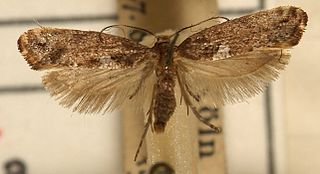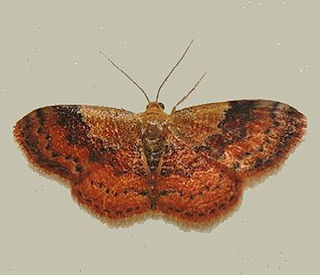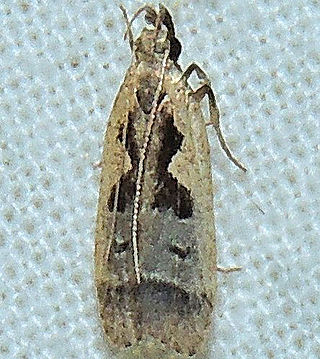
The Acrolepiidae are a family of moths known as false diamondback moths. In modern classifications, they are often treated as a subfamily (Acrolepiinae) of the family Glyphipterigidae.

Urodidae, whose species are commonly known as false burnet moths, is a family of moths in the lepidopteran order. It is the type genus in the superfamily, Urodoidea, with three genera, one of which, Wockia, occurs in Europe.

The genus Crambus includes around 155 species of moths in the family Crambidae, distributed globally. The adult stages are called crambid snout moths, while the larvae of Crambus and the related genus Herpetogramma are the sod webworms, which can damage grasses.

Zanclognatha is a genus of litter moths of the family Erebidae. The genus was erected by Julius Lederer in 1857.

Micropterix mansuetella is a species of moth belonging to the family Micropterigidae and can be found in Europe, in very wet woodlands, fens and carrs. The imago was described by Philipp Christoph Zeller in 1844, but the larva and pupa are poorly described.

Leptostales is a genus of moths in the family Geometridae.

Mompha idaei is a moth in the family Momphidae first described by Philipp Christoph Zeller in 1839. It has a Holarctic distribution; in North America it is found from coast to coast in the boreal forest south to Colorado and Washington.
Micropterix rablensis is a species of moth belonging to the family Micropterigidae, which was described by Philipp Christoph Zeller in 1868. It is probably restricted to Carinthia in Austria and to the adjacent areas of Styria in Austria and Italy and potentially of Slovenia. Its Croatian, Romanian and French existence is doubtful.
Micropterix sicanella is a species of moth belonging to the family Micropterigidae that was described by Philipp Christoph Zeller in 1847. It is known from mainland Italy, Sicily, Sardinia and Corsica.

Chrysoteuchia topiarius, the topiary grass-veneer moth, subterranean sod webworm or cranberry girdler, is a moth of the family Crambidae. The species was first described by Philipp Christoph Zeller in 1866. It is found in most of North America.
Bandera binotella is a species of snout moth in the genus Bandera. It was described by Philipp Christoph Zeller in 1872. It is found in North America, including Texas, New Mexico, California, Colorado and Alberta.
Caryocolum tischeriella(Zeller, 1839) is a moth of the family Gelechiidae. It is found in Portugal, Spain, France, Germany, Austria, Switzerland, Italy, the Czech Republic, Slovakia, Slovenia, Croatia, former Yugoslavia, Romania, Bulgaria, North Macedonia, Greece, Norway, Finland, the Baltic region and Russia, as well as on Crete and Sicily. Outside of Europe, it is found in southern Siberia, Central Asia and North Africa.

Herpetogramma abdominalis is a species of moth in the family Crambidae. It was described by Zeller in 1872. It is found in North America, where it has been recorded from Washington state, east to Nova Scotia, and south to Mississippi and North Carolina.
Agonopterix nebulosa is a moth in the family Depressariidae. It was described by Zeller in 1873. It is found in North America, where it has been recorded from Arkansas, Illinois, Iowa, Maine, Maryland and Virginia.

Dichomeris bilobella, the bilobed dichomeris moth, is a moth in the family Gelechiidae. It was described by Philipp Christoph Zeller in 1873. It is found in North America, where it has been recorded from Nova Scotia, southern Quebec and southern Ontario to Maryland, Minnesota, Missouri and eastern Kansas.

Dichomeris ochripalpella, the shining dichomeris moth, is a moth in the family Gelechiidae. It was described by Philipp Christoph Zeller in 1873. It is found in North America, where it has been recorded from southern Quebec and southern Ontario to New Jersey, North Carolina and Arkansas.

Leptostales rubromarginaria, the dark-ribboned wave, is a species of geometrid moth in the family Geometridae. It is found in North America.
Leptostales laevitaria, the raspberry wave moth, is a species of moth in the family Geometridae. It was first described by Geyer in 1837 and it is found in North America.
Leptostales hepaticaria is a species of geometrid moth in the family Geometridae.












